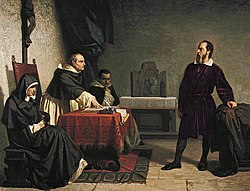Heresy

"Heresy" means ideas or actions that do not agree with traditional religious doctrines. Some religious groups use the word "heresy" to describe beliefs that challenge theirs. A person who has these beliefs is called a heretic.
History
Jewish leaders during Jesus's lifetime called him a heretic because he did not preach traditional Judaism, according to the Gospel of Matthew (26:57-67).
In its first few centuries, the Roman Catholic Church accused religious doctrines like Monophysitism[1] and Arianism[2] of heresy. Later, throughout the Middle Ages, they accused a number of other religious sects (like the Cathars) of being heretical.[3] In the 11th and 12th centuries, thousands of people were burned at the stake for heresy.[4] This execution ritual was supposedly meant to save the heretic's soul. Under torture, many people accused of heresy falsely confessed.
As a result of the Protestant Reformation, the Catholic Church created the Congregation for the Doctrine of the Faith.[5] It is the official doctrine that decides what heresy is and how to deal with it.[5]
Still in the 21st century, Muslims who apostatize are often treated very harshly and frequently killed.
Catholicism and Protestantism
The Catholic Church sees several heresies in Protestantism. For example:[6]
- Protestants claim only scripture (the Bible) is relevant for the faith (sola scriptura); the Catholic Church says traditions are also important.[7]
- Protestants say that belief is enough to be saved (sola fide). Catholics say that good deeds are necessary as well.
- Protestants say that any baptised person can be a priest. In the Catholic and Orthodox churches, priests are ordained. This means that some people are not priests, even though they have been baptised.
- According to Protestants, there is no Transubstantiation during mass (liturgy).
The Roman Missal contains heresies, according to Protestants.
Heresy Media
Saint Nicholas with Arius at the Council of Nicaea, at which he is said to have hit him; Arius was known for preaching that Jesus was created by God and has a lower status, a heresy in Trinitarian Christianity
The burning of the pantheistic Amalrician heretics in 1210, in the presence of King Philip II Augustus. In the background is the Gibbet of Montfaucon and, anachronistically, the Grosse Tour of the Temple. Illumination from the Grandes Chroniques de France, c. AD 1455–1460.
Former German Catholic friar Martin Luther was famously excommunicated as a heretic by Pope Leo X by his papal bull Decet Romanum Pontificem in 1520.
Cristiano Banti's 1857 painting Galileo facing the Roman Inquisition
Mehdiana Sahib: the Killing of Bhai Dayala, a Sikh, by the Mughals at Chandni Chowk, India in 1675
References
- ↑ "CATHOLIC ENCYCLOPEDIA: Monophysites and Monophysitism". www.newadvent.org. Retrieved 2025-03-24.
- ↑ "Arianism | Definition, History, & Controversy | Britannica". www.britannica.com. 2025-03-17. Retrieved 2025-03-24.
- ↑ Mark, Joshua J. "Six Great Heresies of the Middle Ages". World History Encyclopedia. Retrieved 2025-03-24.
- ↑ "Heresy: What Is A Heretic And Why Did It Matter In The Middle Ages?". HistoryExtra: The Official Website for BBC History Magazine. Retrieved 2025-03-24.
- ↑ 5.0 5.1 "Congregation for the Doctrine of the Faith | Roman Catholic Church | Britannica". www.britannica.com. Retrieved 2025-03-24.
- ↑ "CATHOLIC ENCYCLOPEDIA: Protestantism". www.newadvent.org. Retrieved 2025-03-24.
- ↑ "Catechism of the Catholic Church, 82-83".





